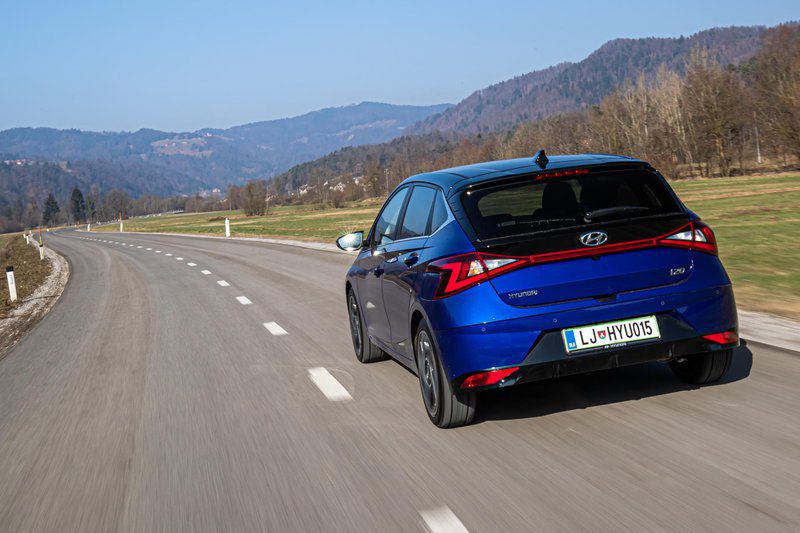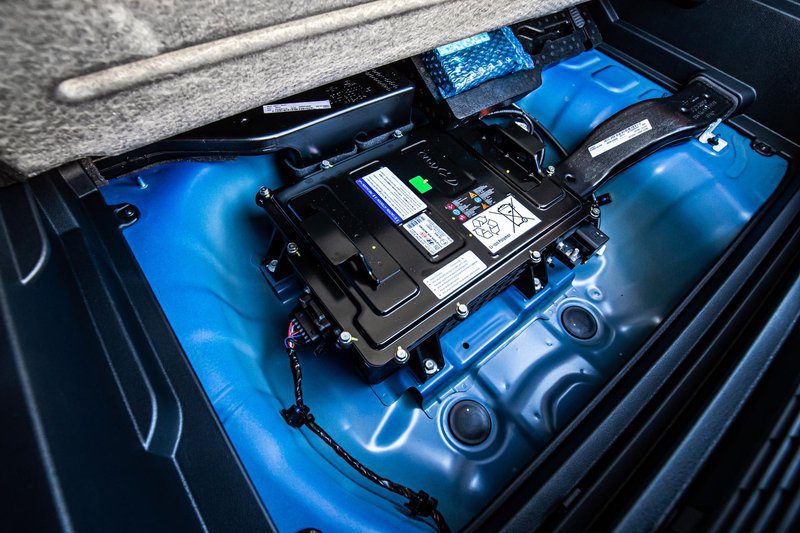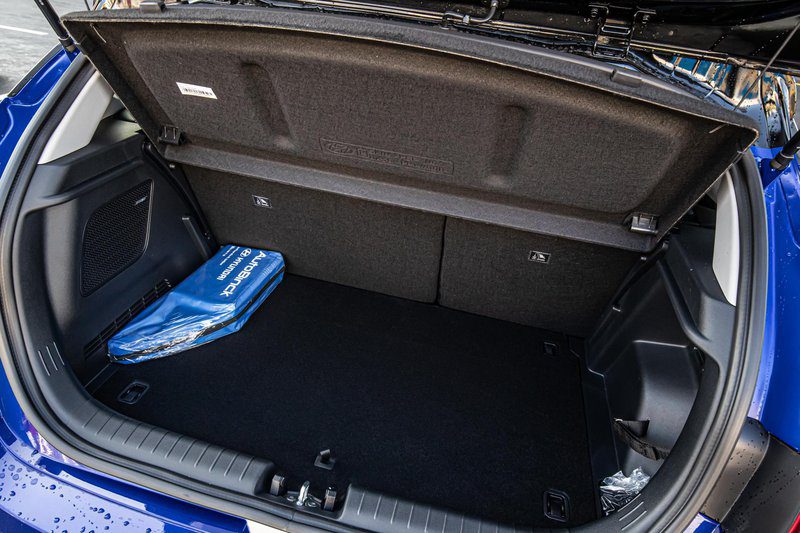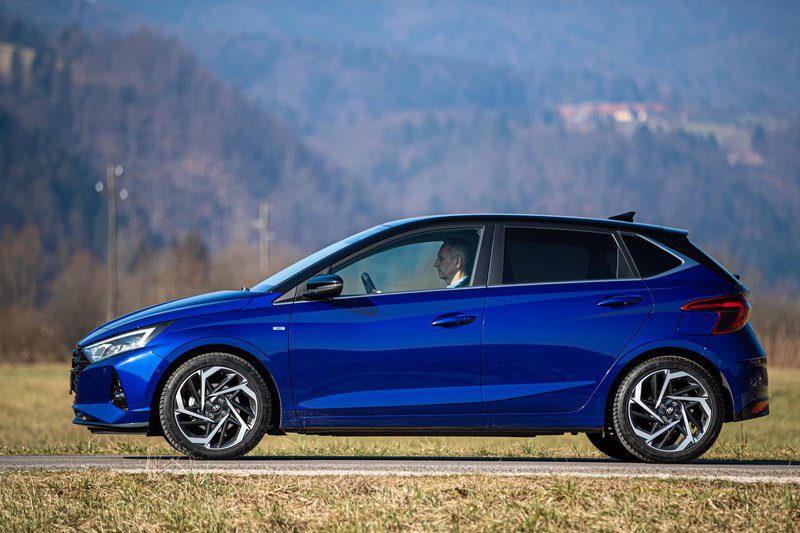
Test: Hyundai i20 1.0 T-GDI (2021) // He Grew Up!
Content
What a power of perspective! If I just remember that Clio slogan from the early 20s that all the big ones have – in fact, it reminds me of how I used to hang out with that iXNUMX – it seems to make real sense just now. But that's how it seemed back then.
Just look at this - At first glance, the i20 says, "I'm growing up." The body lines very clearly express the maturity of not only the car, but also its designers. That they want to go beyond has already been hinted at by the black lacquered C-pillar in the previous generation. It worked kind of nobly, and with it the i20 definitely made it clear that it wants to be premium.
The overall image is now at least a class taller than most toddlers in the segment to which the i20 officially belongs. Modern lines, serious expression, elements that create a play of light and shadow ... All this continues from the side, where the silhouette of the i20 indicates that it is ready for action. The refined design is given a retro touch with a light strip that connects the otherwise very modern rear lights.

I think, however, that the designers with the huge diffuser under the rear bumper have undoubtedly exaggerated. Sure, it works attractively, and it's true that the i20 has a turbocharged engine that is also aided by electricity, but such a diffuser, combined with large rims on low hips, can be attributed to the exciting i20 N at best.. But that's another story... Anyway, the i20 is a kid that gets a lot of attention. Interestingly, however, the newcomer, when I accidentally parked next to my predecessor during our parking lot interaction, actually looks more compact due to its movements. But, looking at the dimensions, this is of course an optical illusion, and no less.
Last but not least, the interior confirms this as the passenger compartment remains one of the most spacious in this segment. It's the same with the luggage compartment (the mild hybrid version is smaller than the other i20s). I am a little outraged by the prevailing blackness of the desert, as it immediately kills the atmosphere in the beautifully designed cabin. I sit low, and then, although at first I somehow can't find a better position behind the steering wheel, which is otherwise heavily adjustable, somehow I just pose and then sit firmly. First of all, the spaciousness is at an enviable level, and it is even more pleasing that there is a lot of space in the back, more than most competitors.
The interestingly designed, four-spoke, heated steering wheel is well adjustable, has good traction and has a number of remote control switches. Through it, I look at the fully digitized dashboard on a 10,25-inch screen. (a piece of standard equipment from the second level of equipment) with two transparent counters and a lot of information in between. Changing the driving style also changes the instrument graphics, so the ambience is slightly different if it is an economical, normal or sporty driving style. And about driving a little later ...
Fortunately, the switches are also classic.
As with the latest generation of Hyundais, there are two 10,25-inch sensors. In addition, the same central infotainment screen, which acts as a dashboard, is located on the top of the center console. There are switches under the screen for accessing the main functions, namely, they are sensitive to touch, which I am not at all thrilled with, but I'm glad they dedicated the classic rotary knob for volume control.

Of course, the huge screen is also touch-sensitive, and the Hyundai BlueLink's connected user interface is already known from other latest-generation home models (i30, Tucson). There is still a lot to be done with the convenience of the user interface, with the ease of access to individual functions, especially in terms of the intuitiveness and transparency of everything it offers. Because it's really rich in content, but some of the features that should be quickly available are hidden in places you might not expect.
And I was actually trying to create an account for Hyundai BlueLink, I tried to connect to enable these features that allow some online services and remote control of the car (check status, fuel quantity, lock, unlock ...) but will go before I was able to set it all up. The owner is likely to have more of the best (and time).
It's nice, though, that they've kept the classic switches on the center console to control the air conditioning. I can also find quite a few of them on the ridge in front of the gear lever (for driving modes, heated seats, turning on the camera (). When I look around, the line of strokes coming from the center vents in front of the passenger in the front seat stands out most positively. Fresh and different At this point, the colorful monotony of black is somewhat broken by the play of light and shadow, but the plastic on most of the dashboard is completely solid.
There is a little more liveliness in the dark that the i20 in the cabin would otherwise deserve. Ambient light contributes to this and the aforementioned drawings of pressure gauges, which are usually painted in white, economy green, and sporty red. I'll tell you later how much sports blood there is in this little one, but I can already tell you that at least a somewhat unusual choice is the gearbox, which in the test model is automatic, namely robotic dual clutch.

I applaud the fact that automatic gearchanges are hard at work in the small car segment, and that's just one of the things that make this kid big. Technique, of course, is also modern; the three-cylinder petrol turbine is powered by an electric motor and a 48-volt battery. Since this is the most powerful petrol version, the power is 88 kilowatts (120 "horsepower") and the torque is 175 Newton meters.If necessary, an additional 12,2 kilowatts can be added, especially when accelerating and starting, the electric motor, which also has an additional and more interesting 100 Nm of torque.
First of all, the engine runs very quietly and quietly, at idle it is barely audible and noticeable. It starts well and accelerates consistently, and is well tuned with a fast gearbox. In economy mode, which is always selected first after starting, no matter what mode was selected before turning off the engine, it gives the impression of calmness, perhaps even restraint. It gains a little more determination by opting for a conventional driving style, but the true picture of what this powertrain combination can show is sporty driving style.
Then the good-natured kid becomes like a little savage, because he seems a little nervous. It responds instantly to commands from the accelerator pedal, the steering gives the impression of a better load, and above all, the automatic transmission maintains low gears even at a higher rev range. And this is the only time I miss the gear lever on the steering wheel even a little.
While one thing is true - regardless of the huge rear diffuser and regardless of the sporty driving style that turns the dial red, you will very rarely drive the i20 in this mode. First of all, economical driving is prohibited, which is one of the reasons why electricity is welcome, as fuel consumption is reduced by several deciliters with mild hybrid technology.
If you are not on a strict diet, it is enough to choose a habitual way of driving. Last but not least, a later switch to Sport mode already raises the engine speed to an audible soundstage. And to higher consumption, which is not really a record low. It ranges from 6,7 to 7,1 liters per 100 kilometers, of course, depending on the driving style, but the engine features smooth acceleration and moderate speeds.
But it's always nice to drive. Partly also because of the low seating position, but above all because of the neat chassis, which, with its precise steering mechanism, always instills enough confidence, even when the road becomes winding and the traffic becomes more intense. It impresses with its balance and predictability in decisive turns, and the steering mechanism communicates well to the driver what is happening under the front wheels. At a higher level of equipment also because the tires on 17-inch wheels have very low hips (cross-section 45), which requires some tax, especially on urban comfort.

After all, in any case, the chassis in the i20 is not synonymous with comfort. It just works way too much, though when combined with the mentioned tires even more (and I suspect that's the main resentment), but the bad roads we mostly hung out on probably add their own. To be clear, of course, this is not felt on the highway, but in urban centers with poorly maintained roads, the tax is considerable.
As an assistant to the constant attention of the driver ...
If with all of that said, the i20 calls attention to growing up in style, it has everything the big ones have – yup, but did I mention it also offers heated rear seats? -, but this is perhaps the most obvious in terms of security. Smart Sense is what Hyundai calls a set of security systems, and looking at the list, it seems like they really haven't forgotten anything. But what's even better is that while driving, the i20 constantly gives the impression that it wants to be at least a small (and sometimes quite large) driver's guardian angel.
Constantly monitors the surroundings, is able to automatically brake in front of obstacles, also recognizes pedestrians and cyclists, brakes when detecting the possibility of a collision at an intersection, First of all, it not only warns me of an obstacle in the blind spot with an audible and visual signal, but also automatically brakes. You know when you leave the side car park and when you miss your car. Of course, it also warns and slows down while driving when I pull out of the parking lot. Recognizes speed limits, can follow lane markings and maintain driving direction. And, yes, for just € 280, cruise control can automatically maintain the distance to the vehicle in front. Do you still doubt whether you will grow up to be the greatest?

The other side of this is of course also reflected in the price list, since the price of such an adult i20 already exceeds 20 thousand, which also already affects the class more. But it's true again - even with the competition, prices for the most equipped (and motorized) versions are at least as high. A brief overview of the offer even reveals that no one offers such a powertrain (turbocharged gasoline engine, mild hybrid technology and automatic transmission) and equipment for the money. First of all, you cannot find so much technology and so much digitization everywhere. You still remember, don't you? Growing up is a really interesting period.
Hyundai i20 1.0 T-GDI (2021)
Basic data
| Sales: | Hyundai Auto Trade Ltd. |
|---|---|
| Test model cost: | 23.065 € |
| Base model price with discounts: | 20.640 € |
| Test model price discount: | 23.065 € |
| Power: | 88,3kW (120 KM) |
| Acceleration (0-100 km / h): | 10,3 with |
| Maximum speed: | 190 km / h |
| Mixed flow ECE: | 5,5l / 100km |
| Guarantee: | General warranty 5 years without mileage limitation. |
| Systematic review | 15.000 km / 12 |
Cost (up to 100.000 km or five years)
| Regular services, works, materials: | 1.162 € |
|---|---|
| Fuel: | 7.899 € |
| Tires (1) | 976 € |
| Loss of value (within 5 years): | 15.321 € |
| Compulsory insurance: | 3.480 € |
| CASCO INSURANCE (+ B, K), AO, AO + | 6.055 ( |
| Calculate the cost of auto insurance | |
| Buy up | € 893 0,35 (km cost: XNUMX €) |
Technical information
| engine: | 3-cylinder, 4-stroke, in-line, turbocharged, front, transverse, displacement 998 cm3, maximum power 88,3 kW (120 hp) at 6.000 rpm - maximum torque 200 Nm at 2.000–3.500 rpm - 2 camshafts per head - 4 valves per cylinder - direct fuel injection. |
|---|---|
| Energy transfer: | the engine drives the front wheels - a 7-speed dual clutch transmission. |
| Capacity: | top speed 190 km/h - 0–100 km/h acceleration in 10,3 s - average fuel consumption (WLTP) 5,5 l/100 km, CO2 emissions 125 g/km. |
| Transportation and suspension: | limousine - 5 doors, 5 seats - self-supporting body - front single wishbones, leaf springs, three-spoke wishbones, stabilizer - rear axle shaft, coil springs, telescopic shock absorbers, stabilizer - front disc brakes (forced cooling), rear disc, ABS, electric rear wheel brake - rack and pinion steering wheel, electric power steering, 2,25 turns between extreme points. |
| Mass: | empty vehicle 1.115 kg - Permissible total weight 1.650 kg - Permissible trailer weight with brake: 450 kg, without brake: 1.110 kg - Permissible roof load: np |
| External dimensions: | length 4.040 mm - width 1.775 mm - height 1.450 mm - wheelbase 2.580 mm - front track 1.539 mm - rear 1.543 mm - ground clearance 10,4 m. |
| Inner dimensions: | longitudinal front 880-1.100 mm, rear 710-905 mm - front width 1.460 mm, rear 1.435 mm - head height, front 960-1.110 mm, rear 940 mm - front seat length 520 mm, rear seat 460 mm - steering ring diameter wheels 370 mm - fuel tank 40 l. |
| Box: | 262-1.075 l |
Our measurements
| T = 7 ° C / p = 1.063 mbar / rel. vl. = 55% / Tires: Dunlop WinterSport 5/215 R 45 / Odometer status: 17 km | |
| Acceleration 0-100km: | 11,1s |
|---|---|
| 402m from the city: | 16,3 years ( 124 km / h) |
| Maximum speed: | 190km / h |
| Fuel consumption according to the standard scheme: | 6,7 l / 100km |
| Braking distance at 130 km / h: | 71,7m |
| Braking distance at 100 km / h: | 42,7m |
| AM table: | 40,0m |
| Noise at 90 km / h | 61dB |
| Noise at 130 km / h | 66dB |
Overall rating (483/600)
There is no doubt that the i20 wants to culminate in the subcompact class. It proves this not only with its bold and modern exterior, modern drivetrain and very good driving characteristics, but also (and perhaps above all) excellent safety systems and equipment that even much larger cars would envy.
Cab and trunk (90/110)
One of the most spacious cabins in the class, especially in the backseat and trunk, which is otherwise smaller in a mild hybrid.
Comfort (76
/ 115)Sits low but good. The touches are nice, but the plastic is mostly hard. The infotainment interface requires more user-friendliness and especially the Slovenian language that it allegedly receives.
Transmission (69
/ 80)The turbocharged petrol engine and 48-volt mild hybrid technology work extremely convincingly. Also in conjunction with an automatic transmission.
Driving performance (77
/ 100)Combined with 17-inch wheels, the rigidly tuned chassis becomes uncomfortable on poor surfaces. However, the center of gravity is low, the position is secure and the handling is good.
Security (109/115)
Hyundai seems to have added a little something to all known safety systems that let you know that the i20 is constantly monitoring you.
Economy and environment (62
/ 80)Consumption, especially if we are talking about a hybrid, may not be so modest at first glance, but the technology is modern and the reasons can be found in the automatic transmission. However, the i20 comes with a five-year unlimited mileage warranty ...
Driving pleasure: 4/5
If I look at it as a sportier version of a toddler, a low center of gravity, a sturdy chassis, low profile tires and a responsive steering gear are certainly in place, but all of this, especially on poor soils, affects comfort. too much.
We praise and reproach
robust chassis
infotainment user experience